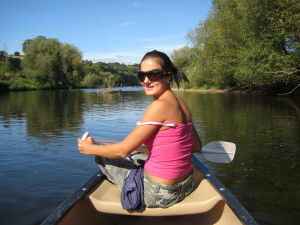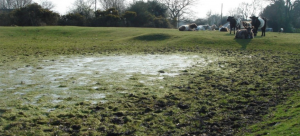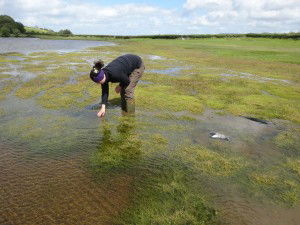Meet the Team: People, Ponds & Water Officer in Wales
18th June 2015
Meet another member of our team, trudging the glorious hills and valleys of Wales to protect our precious pond wildlife
 Hannah exploring the River Wye
Hannah exploring the River Wye
Tell me your name…
Hannah Shaw
And your job title?
Welsh Regional Project Officer for People, Ponds and Water
What does that involve?
It’s all about getting more people interested in ponds and pond conservation. At the minute, it involves identifying and engaging with people that could be volunteers, and training volunteers to undertake the various surveys for PondNet. I am checking out all the randomly-selected grid squares so that a volunteer can survey the ponds there. I’m also going out with volunteers if they want some support to get going.
Anyone can get involved in PondNet, any level of skill or experience. Volunteers with no experience can come to training, and carry out frog & toad and pond habitat surveys or can be paired-up with a more experienced volunteer. For people with more experience, there are the full amphibian, wetland plant and aquatic invertebrate surveys. There are also surveys for some restricted species such as medicinal leech or pillwort; we are actually looking for people to sign up right now, and I’m arranging training very soon.
 A Flagship Pond – one of the best pond sites in the country
A Flagship Pond – one of the best pond sites in the country
I also work on Flagship Ponds, the best of the best ponds in Wales. These ponds have been selected because they are home to very rare plants and invertebrates, or they support really high numbers of plants or invertebrates. I will be working with managers of the nine sites in Wales to help them make sure the pond and species have a secure future. We are also recruiting volunteers to help monitor these Flagship Ponds too.
What’s so important about that?
Well, considering how well studied most of the UK wildlife is, we still don’t know what rarities we’ve got where and we are not aware if these species are declining or being lost. We might be losing things we don’t even know we’ve got. To change that, we are setting up the largest national pond monitoring scheme ever undertaken in the UK. There has only been the Countryside Survey every 10 years and it isn’t frequent enough and doesn’t go into enough detail. The sooner we spot things changing, the sooner we can do something.
It’s also really important to get the message across about appropriate pond management on these Flagship Pond sites so that rare things aren’t lost because of well-meaning but inappropriate management – survey first – know your pond and its inhabitants.
 Poking around in a pond – looking at rare pond plants
Poking around in a pond – looking at rare pond plants
What is your favourite part of your job?
Seeing the delight on people’s faces who have never looked in a pond at night by torch. That is fantastic. And getting to look at so many ponds myself and seeing some really special places and species. I love poking around in ponds, learning about pond ecology, sharing my knowledge and showing other people the creatures that live in ponds – perhaps telling them a little bit about their life histories. It’s also fantastic to be working with some real experts who are also passionate about ponds and the rich biodiversity that they support.
And least favourite?
I’ve been in post for 3 weeks, and I’ve enjoyed everything so far, everything has been extremely interesting but there is just so much to do in setting up such a large project across Wales and I’m working long hours to fit it in but then it doesn’t feel like work because I’m really enjoying myself. I think being an ecologist is a way of life and not just a job. Even driving for hours to visit sites is lovely as I get to drive through the beautiful countryside of Wales.
Why do you do it? What do you get out of it, and what keeps you going through the hard days?
I just want more people to realise how important biodiversity is, how valuable it is, including the rare species. If we are going to do anything for wildlife, and halt biodiversity loss in Wales, we really need to be getting the public involved. Many people have become detached from nature. I’m really concerned about the dwindling number of people with wildlife identification skills and I want to help inspire people to become interested and want to know what they are looking at. People don’t see what they can’t name. I really want to help Wales meet the Biodiversity 2020 targets, but also I want people to see what an uninteresting place it would be if we just had the everyday common species left because they are the generalists and don’t require specialist habitats. People see a river and think it is beautiful but they don’t realise that it is degraded, that it is full of nitrates and phosphates, that the banks are overgrazed, that there are no young trees to replace the bankside trees, and that there are not as many salmon as there should be. I believe that the key to halting biodiversity loss is to protect freshwaters. Freshwaters receive catchment run-off – if you look after the catchment then you are looking after freshwaters and biodiversity.
I suppose I also want to make sure that these amazing creatures and habitats are there for my four-year old son to continue looking at and for his children too. I used to enjoy catching eels and watching water voles when I was small, when they were both really common, but they are almost gone now and I hardly ever see them now. They have both dwindled for different reasons. But on the flip side, I see a lot more otters now than I did when I was small!
 Watching sea lamprey in the River Wye
Watching sea lamprey in the River Wye
What does freshwater wildlife mean to you?
It’s fascinating and has given me a career where I can get outdoors. Species have such wonderful life histories, such as the freshwater pearl mussel which has a larval stage that lives inside the gills of salmon or trout and requires really clean water to develop into a young mussel. There’s always something new to learn, and many are so charismatic creatures with great characters like the common toad.
What’s your favourite freshwater habitat?
Ponds, ponds, ponds! Especially a large pond that has plenty of vegetation, and you can dip in a net and pull out lots of things, or go out with a torch at night, and always learn something new. Like seeing a water stick insect laying eggs and learning what the eggs look like, or seeing the many different intricately built cases of caddis flies.
What got you interested in freshwater habitats?
A trip to Wales when I was four years old is my earliest memory of ponds. I came home with a bucket full of newts, which I kept in an old metal water tank. When I was about nine, I used to buy European tree frog and fire-bellied toad tadpoles by post and I would rear them up. My bedroom was full of native amphibians in tanks and I would overwinter the adults in the big old-fashioned glass sweet jars. I bred water stick insects too for a while – when I found things in a pond I would take them home to study them. Great crested newts were always the most impressive – I think it was their size – and I would rescue them from a friend’s swimming pool. The best Christmas present I remember when I was little, maybe when I was 10 or 11, was an Oriental fire-bellied toad in a little plastic pot of green moss. I had him 15 years! I also kept and bred African aquatic frogs and yellow-bellied toads in my room at University – hiding them in the bottom of the wardrobe and under the bed on room inspection days – and selling the youngsters to the local pet shops.
We moved house several times when I was growing up and I always had to have a pond and if there wasn’t one already my dad would dig me one. My dad dug my first pond when I was eight and the last one he dug for me was after I’d left home and my parent’s had moved into a new house – I was sat outside on the patio in the dark one night in late summer and I saw something move by my foot – it was an enormous female great crested newt. My dad dug a pond and the following spring it was full of great crested newts, smooth newts and frogs – perfect!
